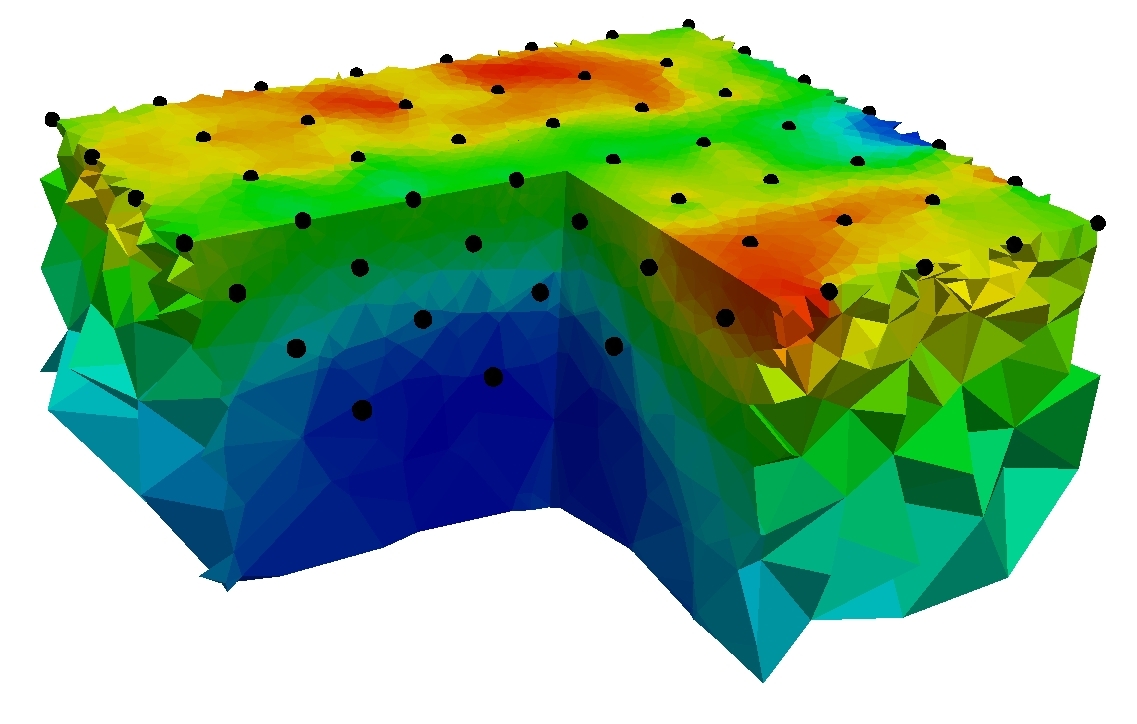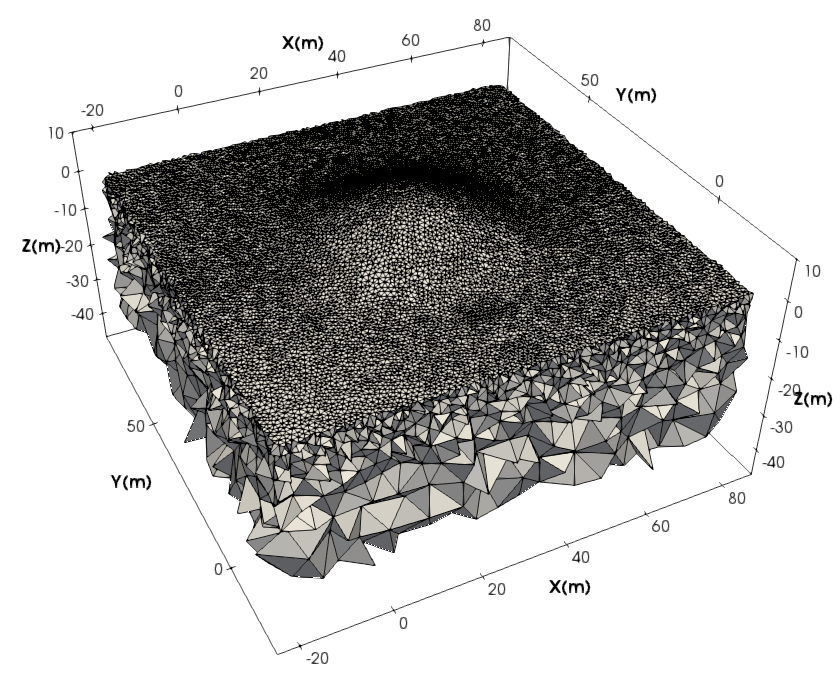R3t version 2.32 February 2024
R3t is a forward/inverse solution for 3D current flow in a tetrahedral or triangular prism mesh. The inverse solution is based on a regularised objective function combined with weighted least squares (an ‘Occams’ type solution) as defined in Binley and Kemna (2005) and Binley (2015).
The user must define the mesh for R3t as a series of elements, each with either 4 nodes (tetrahedron) or 6 nodes (triangular prism). The user must also specify the position of the electrodes within the mesh. The electrodes can be located anywhere in the mesh, provided they fall on node points. Neumann (no current flow) boundary conditions are applied at the boundary of the mesh and so if a half-space is modelled then the mesh should be extended away from the region of interest to account for ‘infinite’ boundaries.

R3t will output calculated parameters (resistivity) for the entire mesh and the user must extract results for the region they wish to study. The region is parameterised in terms of resistivity blocks by grouping patches of elements.
 Measurements are defined in a separate file as a set of four electrode indices. Each electrode is defined as a "string" number and an "electrode" number. Note that the "string" index is used simply to help group electrode strings (for example, surface lines of electrodes or boreholes); the "string" index can be the same for all electrodes if the user wishes not to use this labelling.
Measurements are defined in a separate file as a set of four electrode indices. Each electrode is defined as a "string" number and an "electrode" number. Note that the "string" index is used simply to help group electrode strings (for example, surface lines of electrodes or boreholes); the "string" index can be the same for all electrodes if the user wishes not to use this labelling.
The current version will work with any size problem but the user should be careful about not setting up a problem that is too large for the memory (RAM) available. This is particularly relevant for inverse problems. Keep in mind that the size of the Jacobian (sensitivity) matrix, for example, is the number of measurements x the number of parameters (and each value will be stored as 8 bytes). R3t will output the required memory at the start of execution of the code, but it is advisable to think about memory demands before the mesh is setup.
R3t will output inverse models in x,y,z ASCII format suitable for plotting with third party software. R3t also produces vtk formatted output allowing quick plotting with Paraview
Changes from R3t v.2.31
If starting model satisfies convergence the model is output (previously a blank file was saved).Changes from R3t v.2.3
Corrected output of difference results for non-converged case.Changes from R3t v.2.2
Output vtk file will now contain percentage difference in resistivity if a difference regularisation is used.Changes from R3t v.2.1
Added an option to read pre-computed node and element connectivity matrices to reduce computation overhead at execution.Changes from R3t v.2.01
Added resolution matrix calculations and option to store jacobian and roughness matrix.Changes from R3t v.2.0
Minor bug fixes and output of number of measurements in line 1 of forward model output (to be consistent with R2 v4.0).Changes from R3t v1.9
Major changes to input file R3t.in to be consistent with R2 v4.0. Added input file checks. Apparent resistivity checks on input. Electrode checking on input. Added misfit target decrease option as in R2. Output format of fxxx_err.dat changed. Added roughness to main output log.Changes from R3t v1.8
Many changes to the input file R3t.in have been made to make input more comparable to R2. Input file error checks are now made. Error checks on the input of the data file (protocol.dat) are now made (to avoid incorrect electrode numbering). Documentation has been improved and more examples included.Download R3t
Note that there is no installation script to run. The R3t executable should be copied to a working folder and run from there. R3t runs on a 64bit Intel compatible processor. Examples are provided (see download below).User guide (pdf)
Download R3t program and guide ( .zip file)

ResIPy (formerly pyR2): NEW Python GUI for R3t (and sister codes)
Guillaume Blanchy (Lancaster), Sina Saneiyan (Rutgers) and Jimmy Boyd (Lancaster) have developed ResIPy: a python GUI for R3t and sister codes. The GUI is open source and standalone executables are available at the ResIPy gitlab site. More information is also available at the ResIPy ResearchGate site. See also the ResIPy YouTube channel . Details of ResIPy can be found in Blanchy et al.(2020).Example applications of R3t (send more to A Binley)
"Evaluation of electrical resistivity tomography (ERT) for mapping the soil - rock interface in karstic environments" by Cheng et al.(2019)"Characterization of karst structures using quasi-3D electrical resistivity tomography" by Cheng et al.(2019)
"Use of small scale electrical resistivity tomography to identify soil-root interactions during deficit irrigation" by Vanella et al.(2018)
"Time-lapse Mise-á-la-Masse measurements and modeling for tracer test monitoring in a shallow aquifer" by Perri et al.(2018)
"Characterization of reactive transport by 3-D electrical resistivity tomography (ERT) under unsaturated conditions" by Wehrer et al.(2016)
"Monitoring soil-plant interactions in an apple orchard using 3D electrical resistivity tomography" by Boaga et al.(2013)
"Monitoring freshwater salinization in analog transport models by time-lapse electrical resistivity tomography" by Wagner et al.(2013)
A saline tracer test monitored via both surface and cross-borehole electrical resistivity tomography: Comparison of time-lapse results" by Perri et al.(2012)
Comparing Plume Characteristics Inferred from Cross-Borehole Geophysical Data" by Haarder et al.(2012)
"Tracer Movement in the Unsaturated Zone: Frostbitten results" by Haarder et al.(2011)
"Spatial variability in free phase gas dynamics in a Northern peatland" by Terry et al.(2011)
"Noninvasive 3-D Transport Characterization in a Sandy Soil Using ERT" by Koestel et al.(2009)
"Quantitative imaging of solute transport in an unsaturated and undisturbed soil monolith with 3-D ERT and TDR" by Koestel et al.(2008)
References
Binley, A., 2015, Tools and Techniques: DC Electrical Methods, In: Treatise on Geophysics, 2nd Edition, G Schubert (Ed.), Elsevier., Vol. 11, 233-259, doi:10.1016/B978-0-444-53802-4.00192-5. (available from the author on request).Binley, A. and A. Kemna, 2005, Electrical Methods, In: Hydrogeophysics by Rubin and Hubbard (Eds.), 129-156, Springer
Blanchy, G., S. Saneiyan, J. Boyd, P. McLachlan and A. Binley, ResIPy, 2020, an intuitive open source software for complex geoelectrical inversion/modeling in 2D space, Computer & Geosciences, 137, doi:10.1016/j.cageo.2020.104423.
